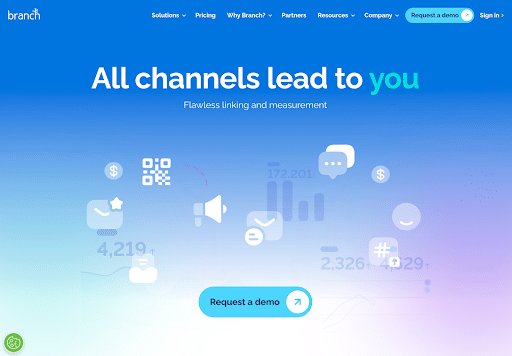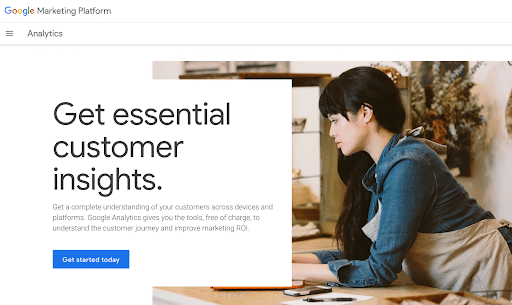If you’re running any kind of marketing campaign, you need to know what’s working. That means tracking more than just traffic. It means tracking the right links.
URL tracking gives marketers the power to tie every click back to a source, campaign, and channel, unlocking actionable data to optimize performance and prove return on investment (ROI). However, not all tracking methods are created equally. And without the right tools or setup, you risk losing data across platforms, channels, or devices.
In this guide, we’ll walk through exactly how URL tracking works, what methods are most effective, which tools marketers actually use, and how platforms like Branch go beyond clicks to deliver post-click attribution and real revenue insights.
What is URL tracking and why does it matter?
URL tracking is one of the most essential tools in a marketer’s toolkit. It allows you to understand how visitors are getting to your content, which efforts are generating results, and where your strategy might need adjustment. Whether optimizing paid ad spend or refining email performance, tracking URLs is the foundation for effective measurement.
How URL tracking works
A tracking URL is a modified version of a standard link that includes special parameters to record specific details about a user’s journey. These extra bits of data — often added through query strings — help marketers determine where traffic is coming from and what it’s doing once it arrives.
Tracking code, such as UTM parameters or custom campaign tags, powers most tracking links. When a user clicks on the tracking URL, it routes them to the intended website URL, sometimes through one or more redirects. During that process, data is captured and sent to an analytics platform.
Once set up, these tracking links generate a wealth of actionable metrics — from click-through rates (CTRs) to bounce rates to conversion rates — allowing you to monitor campaign performance with far more precision than raw traffic numbers alone.
Benefits of tracking URLs in campaigns
Without tracking, you’re guessing. With it, you’re learning — and more importantly, improving.
URL tracking allows marketers to optimize their campaigns based on actual performance data, not assumptions. Whether you’re running paid ads, organic content, or multichannel outreach, URL tracking powers better campaign tracking and more efficient spend.
It also unlocks the ability to analyze traffic patterns in real time, which means faster iteration and quicker pivots when something isn’t working. When paired with behavior analytics tools, tracking helps surface valuable insights about user behavior — like which links drive engagement, what devices are being used, or where drop-off occurs in the funnel.
More broadly, tracking supports smarter marketing efforts by giving you a clear picture of how each campaign contributes to the bottom line. And by connecting the dots between clicks and conversions, URL tracking improves attribution, helping you give credit where it’s truly due.
Examples of campaigns using URL tracking
Nearly every modern campaign, regardless of channel or objective, can benefit from URL tracking. Here are a few real-world examples:
- A social media team running posts on multiple platforms uses tracking URLs to compare Instagram performance to X (Twitter) or TikTok.
- An email campaign promoting a product launch includes separate tracking codes for each call-to-action (CTA) button and image link, revealing which drives more clicks.
- Performance marketers launching ad campaigns on Google and Facebook use unique URLs to measure how each platform and ad set performs.
- A blog team focused on driving traffic to product pages uses UTM-tagged links to differentiate between organic, paid, and referral sources.
- A B2B company shares a lead magnet on LinkedIn and uses a tracking URL to isolate results from paid vs. organic posts.
- Large-scale digital marketing campaigns deploy hundreds of short links across web, mobile, and email to measure impact at scale.
In each case, URL tracking transforms scattered data into a story you can act on.
Three core methods of URL tracking
There are several ways to implement URL tracking, each with its own advantages depending on your goals, channels, and tech stack. Below are three standard (and complementary) methods marketers use to effectively track URLs and extract campaign insights.
1. Using UTM parameters
UTM parameters are the most widely used method for URL tracking. Originally developed by Urchin (acquired by Google), these tags are appended to URLs to help identify the source, medium, and intent of traffic. When used correctly, they give you powerful visibility into how each link contributes to campaign performance.
Here’s a breakdown of the most common UTM parameters:
- **utm_source** – Identifies the platform or origin of the traffic (e.g., Facebook, newsletter)
- **utm_medium** – Specifies the type of traffic (e.g., email, CPC, social)
- **utm_campaign** – Defines the specific campaign name for the promotion
- **utm_content** – Differentiates versions of a creative, such as A/B test variants
- **utm_term** – Tracks paid keywords in search engine ads (often used with Google Ads)
When you’re building tracking links using a campaign URL builder, many tools will autogenerate these tags for you. Some platforms even allow you to save a template so you can standardize parameters across teams.
To get the most out of UTM parameters, always include a consistent campaign source, campaign medium, and campaign content — especially when comparing multiple channels. This ensures your analytics platform can correctly bucket and attribute performance data.
2. Using shortened links
While UTM-tagged URLs are incredibly useful, they’re not always ideal for direct sharing — especially on platforms with character limits or in environments where a clean aesthetic matters.
That’s where shortened links come in.
Most shorteners allow you to convert long URLs (including ones with detailed tracking parameters) into concise, branded links. You can share these across social media, SMS, print, or affiliate networks without them looking cluttered.
Even better, some shorteners provide insights into CTRs, letting you see which links perform best and where users are engaging. This can be especially helpful for top-of-funnel testing or influencer-driven campaigns where branding and performance go hand in hand.
3. Using deep links for advanced attribution
Basic UTM tracking shows you who clicked a link, but deep links go further. They can route users directly to a specific screen or product inside a mobile app, improving both the landing page experience and downstream engagement.
This is particularly powerful when tracking referral campaigns or user acquisition funnels. With deep linking, the context of the original link (e.g., source, medium, creative) can be passed through install flows — even on iOS, where privacy changes have made traditional attribution more difficult.
Platforms like Branch support deep links that preserve metadata, enabling full-funnel attribution from click to conversion. This bridges the gap between marketing and product analytics and gives marketers a more complete picture of performance, especially in mobile-heavy environments.
See how Branch deep links support full-funnel attribution.
Top tools for effective URL tracking
Now that you understand the fundamentals of URL tracking, the next step is choosing the right tools to execute and measure your efforts. Below are some of the most widely used platforms for tracking links and understanding campaign performance — ranging from beginner-friendly analytics to enterprise-grade solutions.
Branch
Alt. Text: Branch’s homepage (Source)
Branch is a powerful attribution and linking platform built for modern marketers. Unlike basic link shorteners or static UTM-based tools, Branch helps you track users across platforms and devices — from click to conversion.
One of Branch’s standout features is its robust API, which enables advanced link generation, automated campaign tagging, and real-time data syncing across your internal systems. This makes it ideal for growth teams, product marketers, and mobile-first companies who want to unify data from web, app, and offline channels.
Branch also supports deep linking, post-install attribution, and user journey stitching, delivering insights beyond traditional click counts.
Google Analytics
Alt. Text: Google Analytics’s homepage (Source)
Marketers of all sizes most commonly use Google Analytics as their web analytics tool. It’s free, integrates easily with other Google products (like Ads and Tag Manager), and offers a comprehensive view of user traffic, behavior, and conversions.
When used with UTM-tagged URLs, Google Analytics allows you to track campaign performance across channels like email, paid search, and social. Inside the dashboard, you can compare source/medium traffic, bounce rates, session durations, and goal completions — all linked back to your tracking URLs.
While Google Analytics excels at top-level reporting, it may fall short for mobile attribution, deep linking, or post-click engagement data — areas where Branch picks up the slack.
Other tools (e.g., Bitly, Rebrandly, and TinyURL)
For marketers focused on branded links and social sharing, tools like Bitly, Rebrandly, and TinyURL provide lightweight yet practical tracking capabilities.
These platforms offer basic analytics tools that track clicks, referrers, and device types. They’re especially useful when sharing content in environments with limited space, like SMS, influencer shoutouts, or promotional banners.
Some tools even integrate with search engine campaigns, providing URL-level performance insights for cost-per-click (CPC) and pay-per-click (PPC) ads. If you’re running paid search campaigns on platforms like Google or Bing, pairing shorteners with UTM tags can improve campaign clarity and post-click optimization.
While these tools lack deeper attribution or in-app analytics, they’re perfect for quick-win tracking and user-friendly link management.
Branch helps you track beyond the click — across installs, apps, and channels. Request a demo today.
3 common mistakes marketers make when deploying URL tracking
Even experienced marketers can fall into common traps when managing tracking URLs. These issues may seem small, but they can lead to misleading data, broken attribution models, and missed opportunities. Below are three of the most frequent mistakes (and how to avoid them).
1. Inconsistent naming conventions
One of the most common and costly mistakes in URL tracking is failing to use consistent naming conventions across campaigns. When different team members use different spellings, capitalizations, or formats for UTM parameters (e.g., utm_source=Facebook vs. utm_source=facebook), analytics platforms will treat them as separate sources.
The result? Fragmented data, skewed reports, and a lot of cleanup later.
To prevent this, establish a shared UTM naming system across your team or organization. Document how to format campaign names, mediums, and sources, and consider using a URL builder with predefined templates to enforce consistency.
2. Losing data across channels
Marketers often focus on a single source of truth — like Google Analytics — while overlooking how different marketing channels handle redirects, cookies, or tracking parameters. This can lead to gaps in data, especially when users move from web to mobile or across different devices.
For example, if someone clicks an Instagram ad on their phone and is routed through multiple redirects before landing in your app, it’s easy to lose visibility into the original source if your tracking setup isn’t robust.
To maintain full-funnel attribution, ensure your links and tracking tools support cross-channel journeys. Platforms like Branch can help unify user paths across web, app, and other touchpoints, closing the attribution loop.
3. Overlooking post-click behavior
A lot of marketers stop measuring performance at the click, but email marketing, paid social, and display campaigns rarely succeed based on CTR alone. What happens after the click is just as important.
Failing to measure post-click actions, like page views, form fills, or purchases, can lead to flawed assumptions and underperforming strategies. A solid marketing strategy should combine URL tracking with conversion tracking, behavioral analytics, and downstream metrics.
By looking beyond the click, you’ll uncover which campaigns drive meaningful engagement and which ones just inflate your traffic numbers.
How Branch simplifies URL tracking and attribution
While many tools can help you track URLs and analyze clicks, few go beyond that to connect every step of the user journey — from the first tap on a social ad to an in-app purchase weeks later.
That’s where Branch stands apart.
Deep linking for seamless UX
Branch’s deep linking technology allows marketers to direct users not just to an app or webpage, but to exactly the right place inside that experience. Whether you’re promoting a product page, reengaging inactive users, or running a referral campaign, Branch links carry context across every touchpoint.
Unlike traditional URLs or UTMs that drop data during redirects, Branch deep links preserve campaign metadata through app installs and reopens — delivering a seamless user experience and more reliable attribution, even on iOS.
Unified analytics across channels
Branch unifies link tracking and attribution across web, mobile, connected TV (CTV), QR (quick response) codes, and more. Instead of juggling separate dashboards for each platform, marketers get one centralized view of campaign performance across all digital and offline marketing channels.
That means you can see which links drive installs, signups, purchases, or other downstream actions — no matter where the user started or what device they used. Branch also integrates with your customer relationship management (CRM) system, ad platforms, and product analytics tools to ensure your data flows where you need it.
The result? Fewer blind spots. Smarter decisions. Better ROI.
See how top brands succeed with Branch.
What Branch customers have to say
Many leading brands have turned to Branch to level up their tracking and attribution.
- Gaming companies like Funstage and Platogo use over 1 million deep links per month to drive retention and player loyalty, tracking every click and in-app action across campaigns.
- The fintech app Tunaiku saw a 23% increase in app downloads after switching to Branch, using deep links to better measure and optimize its acquisition funnel.
- Flipkart, one of India’s largest e-commerce platforms, used Branch to run discovery ad campaigns that delivered 50x return on advertising spend (ROAS) and $10 million+ in gross merchandise value (GMV) — attributing every click, install, and purchase to the right source.
These aren’t just tracking improvements — they’re revenue-driving outcomes powered by better data and better links.
Ready to unlock deeper attribution and better campaign data? Get deeper insights from every click — request a Branch demo today.



